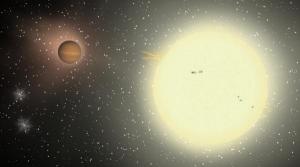This is a large planet but with an extremely low density, and it is possible that its upper atmosphere is constantly being ejected into space

Pictured is an artist rendering of TrES-4 (left) orbiting its sun, which is a star larger and hotter than the sun, and 10 times the size of the planet. Astronomers estimate that TrES-4's large volume and low density cause small portions of the planet's outer atmosphere to be pushed into space and form a comet-like mantle or tail behind the planet. Illustration - Geoffrey Hall, Mitzpe Lowell.
An international team of astronomers, who conducted a survey to search for planets outside the solar system as part of the Trans-Atlantic Exoplanet Survey, announced this week the discovery of TrES-4, a new planet in the Hercules group.
The new planet was spotted by astronomers looking for transiting planets – that is, a planet passing in front of its sun from our perspective. The survey is carried out using several automated telescopes in Arizona, California and the Canary Islands. TrES-4 was discovered at a distance of less than half a degree (about the size of the full moon) from the third planet of the group - TrES-3.
TrES-4 is the largest planet discovered so far using this method, says Georgi Mendoshev, an astronomer at the Lowell Observatory and lead author of the paper announcing the discovery. "It is about 70% larger than Jupiter, but less massive than it and this means - a very low density of the planet - 0.2 grams per cubic centimeter and since the gravity of such a planet is not high, it is possible that this causes its atmosphere to escape and form a kind of comet tail.
TrES-4 is 1,400 light-years away and orbits its parent star for three and a half days, at a distance of about 7 million kilometers. Therefore it is also hot - about 1,600 degrees Kelvin. "This planet is a problem for theorists," says Edward Dunham, also from the Wall Observatory. "It is relatively large for its mass and the models talking about the hot justices will require a renewed explanation. In any case, problems are a good thing, because we can learn new things while solving them."
"We continue to be surprised by how big a giant planet can be," adds Francis O'Donovan, a research student in astronomy at the California Institute of Technology who operates one of the telescopes of the TrES project. "But if we can explain the size of these planets in their harsh environment, it may be possible to better understand how the planets formed and behave in our solar system."

5 תגובות
Boring
There is no uniqueness and no emphasis should be placed on the "new" cubes that are being shaped and created all the time, the universe is a dynamic place that flows and changes, all the time.
From the little I understood and for the sake of illustration, if theoretically a space vehicle tries to land on top of that planet at some site, and because of its "low density" would the vehicle not be braked by the planet's soil, but sink or even pass through it?
It's amazing how surprised we are every time
Discoveries in space.
We have to get out of the current patterns and it is even allowed
Let's let the imagination work a little.
Then less surprised.
Question and hypothesis.
The question is, if the star is constantly evaporating into the space around it, how did the material get to the star? That is, how could it have been created in the first place if it is unable to maintain mass?
hypothesis. The star formed far away from the Saturn it orbited. He was cold. Over time, it came closer to the above-mentioned Saturn, because of an event that happened or because of primary reasons in the formation process, such as too low a speed, which does not allow for a full circular orbit.
When it got closer to the star, it started to heat up, and the material it is made of started to spread, maybe even went into a state of accretion.
The matter took up less space and the density is small, hence the gravitational force of the star, although it remains constant at first, is unable to pull the matter from spreading through space. As time passes, the force of gravity weakens, and the gases spread more easily due to the weakening of the force and perhaps even due to the increase in temperature during the invention of a bright side of the star from the radiation of the star Sabbat.